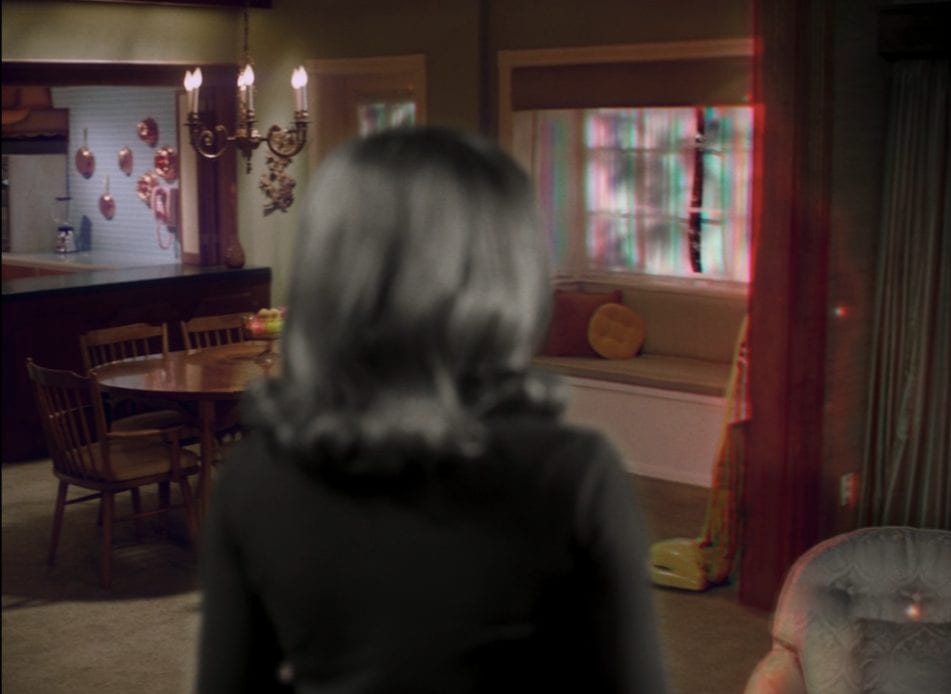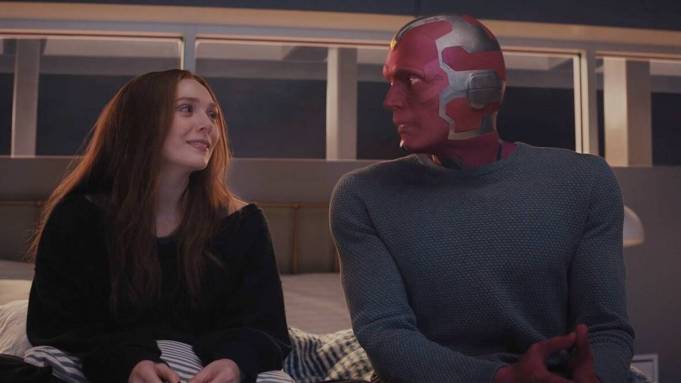“It’s not fair. It shouldn’t be you, but it is.”

That’s what Vision told Wanda Maximoff when he begged her to destroy the Mind Stone and himself with it in Avengers: Infinity War. The superhero couple shared a mere 20 minutes total in the subsequent Avengers films but the love story burgeoning between witch and a human-like synthezoid got its hooks in me early on. That’s why when WandaVision was announced, I had no expectations other than pure excitement.
Over the course of its nine episodes, WandaVision — in its wry and clever way — destroyed me and made me whole at once, much like Wanda herself.
Grief as a Manifestation of Magic
Wanda’s powers have been innately tied to grief and sorrow since she lost her brother Pietro in Avengers: Age of Ultron. While we mostly saw her harnessing her anger and rage towards Thanos in Avengers: Endgame, by the end of that film, she was silent and solemn at Tony Stark’s funeral.
Many times in Marvel productions, women’s sorrow and suffering has been overlooked or at best, highly compartmentalized — Black Widow’s stubbornness to carry on and her ultimate sacrifice in Endgame, Peggy Carter destroying Captain America’s blood at the end of season one of Agent Carter — so for Wanda’s despair to literally manifest into an entire spin-off series is a huge development in terms of delving deeper into these larger-than-life characters and their bruised and battered souls. And Wanda’s journey is one through the five stages of grief — denial, anger, bargaining, depression, and acceptance.
When WandaVision opens, Wanda’s none the wiser to where she is and what’s happening. For the first two episodes, she’s in complete denial, living out her magical sitcom dreams as a newlywed and housewife in black and white. The only twinges of reality come through in the form of commercials referencing upsetting moments throughout her life. It isn’t until she realizes she’s pregnant that everything becomes technicolor and vastly much more complicated.

It’s then that her magic begins to slip and she begins to awaken from the hexagon dreamworld she’s created — and is holding others captive in. When Monica Rambeau tries to break Wanda’s dream state by reminding her that Pietro was killed by Ultron, Wanda’s anger is unleashed, and after throwing Monica from the hex, it’s then she sees Vision for what he is — dead and gone. Up until that point, many viewers wondered if she was using her powers to puppet his dead form in her dreams. Later on, we find this not to be the case, and it is in fact her grief’s pure ability to manifest the Vision she loved and lost.
Once a new version of Pietro shows up and her and Vision’s children grow, Vision becomes more aware of what’s going on, it’s then that Wanda begins to bargain to keep the dream intact in and outside of the hex. She threatens the S.W.O.R.D. team, with a flick of her wrist and, begins to expand the hex outward. Inside the dream though, she’s more susceptible to the twins’ demands and Vision’s frustrations.
It’s only when Agatha Harkness captures Wanda and makes her face her past one traumatic event at a time that we truly see the potential scope of Wanda’s powers. Without truly understanding her abilities, she has been able to protect herself and those she loves over the course of her life. It is the moment when she fails that the feelings of depression sink in, as she tells Vision in a flashback:
“It’s just like this wave washing over me, again and again. It knocks me down, and when I try to stand up, it just comes for me again. And I…It’s just gonna drown me.”
At that moment, Vision delivers the line at the heart of WandaVision itself and maybe even the MCU in a broader sense:
“What is grief if not love preserving?”

For every special power a superhero gains, there is inevitably a weakness they must face or something or someone they’ve loved that they must eventually give up. In Wanda’s case, her power is both her weakness and strength. When pushed too far by Tyler Hayward’s cruel comments that Vision’s body is not hers to bury and realizing that she’ll never build a home with Vision, that’s when her grief overwhelms and she holds an entire town captive so she can, as Agatha points out, have breakfast for dinner.
So Long, Darling: Unraveling Layers and Lifetimes
To me, the most ironic part of Wanda’s powers being considered chaos magic is the fact that she uses it to create stability. By tapping into her grief, she gives herself the life she always wanted with Vision — an entire lifetime spread out over decades as newlyweds and new parents. She gives herself the one thing she’s never had from childhood onward — a stable foundation with a family that cannot be hurt or taken from her.
Monica Rambeau understands why — she even admits to Wanda she’d bring her mother back if she could. And wouldn’t we all? I once had specific blueprints for my life and over time, I’ve had to develop my own ways of coping and understanding myself. The fact that Wanda builds a world inspired by classic sitcoms makes complete sense. I grew up on those shows, watching back-to-back episodes during marathons (which would now be considering binging). It’s comfort food in celluloid form, which Lelaina Pierce in Reality Bites sums up as:
“I just don’t know why things can’t go back to normal at the end of the half hour, like on [The] Brady Bunch or something.”
But there is no such thing as normal, and in WandaVision, the thin lacquered layer of humor hides the dull pain underneath. To heal and come into her own, Wanda must absorb and process all the anguish that fate has dealt her. It is then that she becomes who she was always meant to be: The Scarlet Witch.

I’ve seen rumblings of people being upset that there was no tease for the next big villain in MCU’s Phase 4, nor any star-studded Easter eggs for us to gawk over until the next film comes out. But this was Wanda’s story from start to finish — and sometimes the biggest and hardest obstacle we can face is ourselves.
Consider the moment Wanda destroys Vision in Avengers: Infinity War. While Vision serenely accepts his death to save half the universe, Wanda can’t. He IS her universe. She’s shaking, her eyes spilling over with tears. She only relents when Vision tells her what she needs to hear:
“It’s alright, you could never hurt me…I just feel you.”
When Wanda sees Vision’s dismantled form in the S.W.O.R.D. facility, she waves her hand over his crushed skull and laments in the most heart-wrenching call back: “I can’t feel you.”
Now, consider the ending of WandaVision, where after saying goodnight (and effectively goodbye) to their children, Wanda reveals to Vision what he truly is:
Wanda: “You, Vision, are the piece of the Mind Stone that lives in me. You are a body of wires and blood and bone that I created. You are my sadness and my hope. But mostly, you’re my love.”
Vision: “I have been a voice with no body. A body, but not human. And now a memory made real. Who knows what I might be next? We have said goodbye before, so it stands to reason–
Wanda: We’ll say hello again.
And then at that moment, everything is stripped away, the layers and decades she cocooned them in as they began to wake from the dream she created out of her own love for Vision persevering in spite of death, time, and reality itself.
This time, Wanda is the one who is serene, with Vision dissolving into gold dust, and standing in the empty plot of land he bought for them. Wanda has accepted that this particular dream is over until she can hone her powers and conjure another. Whether or not the cycle of grief starts anew for her in Phase 4 of MCU, what an extraordinary arc WandaVision was for this unusual and deserving couple.


